Operations Management: Theories, Approaches, Functions, and Objectives
VerifiedAdded on 2021/04/16
|19
|1975
|137
Report
AI Summary
This report delves into the multifaceted realm of operations management, elucidating its significance in achieving business objectives. It begins by highlighting the critical role of operations management in ensuring efficient production and service delivery, impacting various organizational departments. The report then explores key theories, including Six Sigma (DMAIC and DMADV methodologies), Lean Production, and Queuing Theory, outlining their methodologies and benefits. Furthermore, it examines different approaches to operations management such as Total Quality Management, Just-in-Time Inventory, and the concept of continuous improvement (Kaizen), discussing their applications and importance. The report also investigates various operations functions, including control and distribution systems, transformation of raw materials, process design, and capacity management, along with the roles of leaders and managers in fostering effective operations. It concludes by emphasizing the importance of strategic decision-making, tactical planning, and day-to-day management in optimizing production and achieving business success, supported by relevant references.

Operations and
Management
Different approaches and their importance
Management
Different approaches and their importance
Paraphrase This Document
Need a fresh take? Get an instant paraphrase of this document with our AI Paraphraser
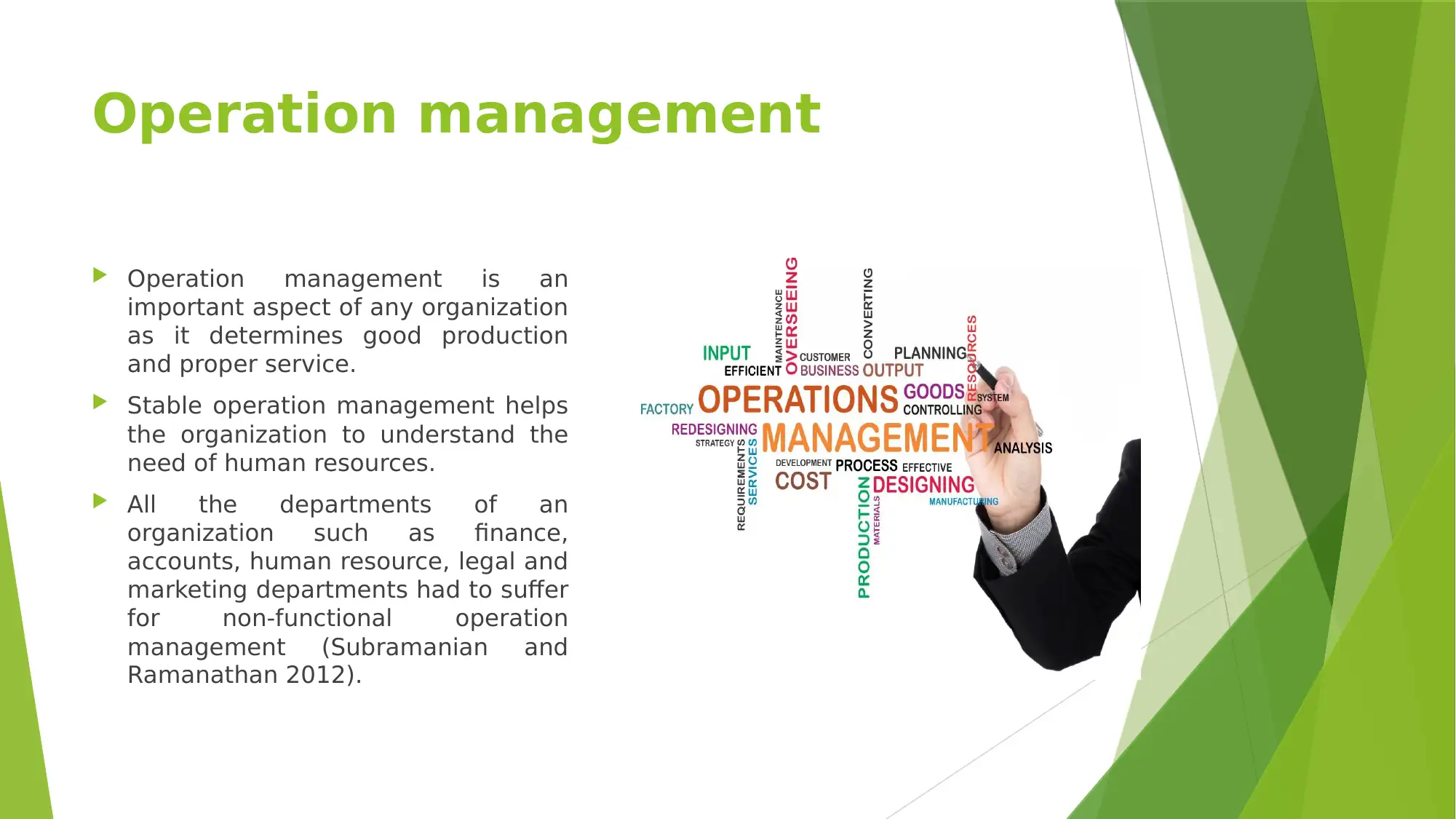
Operation management
Operation management is an
important aspect of any organization
as it determines good production
and proper service.
Stable operation management helps
the organization to understand the
need of human resources.
All the departments of an
organization such as finance,
accounts, human resource, legal and
marketing departments had to suffer
for non-functional operation
management (Subramanian and
Ramanathan 2012).
Operation management is an
important aspect of any organization
as it determines good production
and proper service.
Stable operation management helps
the organization to understand the
need of human resources.
All the departments of an
organization such as finance,
accounts, human resource, legal and
marketing departments had to suffer
for non-functional operation
management (Subramanian and
Ramanathan 2012).
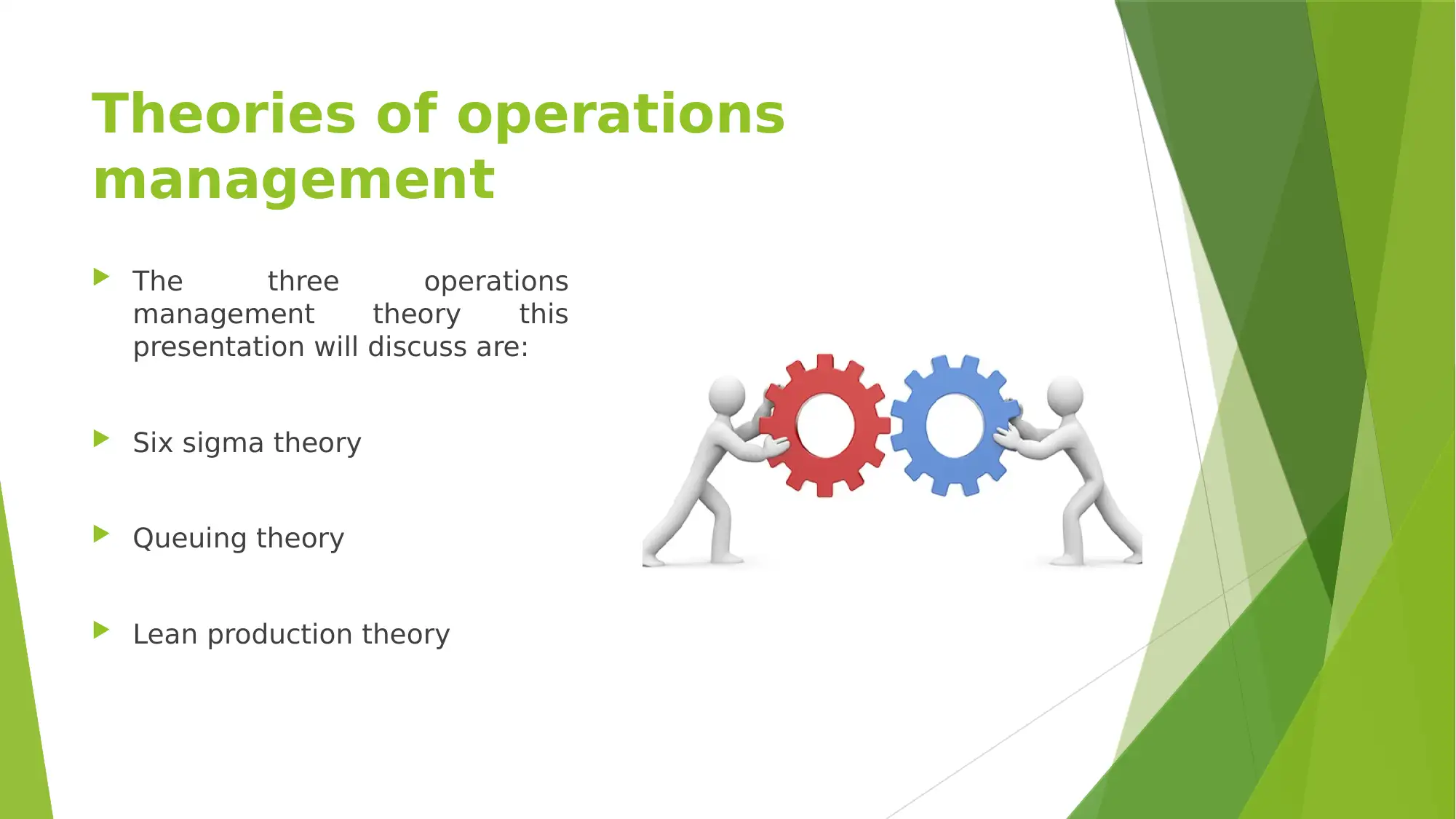
Theories of operations
management
The three operations
management theory this
presentation will discuss are:
Six sigma theory
Queuing theory
Lean production theory
management
The three operations
management theory this
presentation will discuss are:
Six sigma theory
Queuing theory
Lean production theory
⊘ This is a preview!⊘
Do you want full access?
Subscribe today to unlock all pages.

Trusted by 1+ million students worldwide
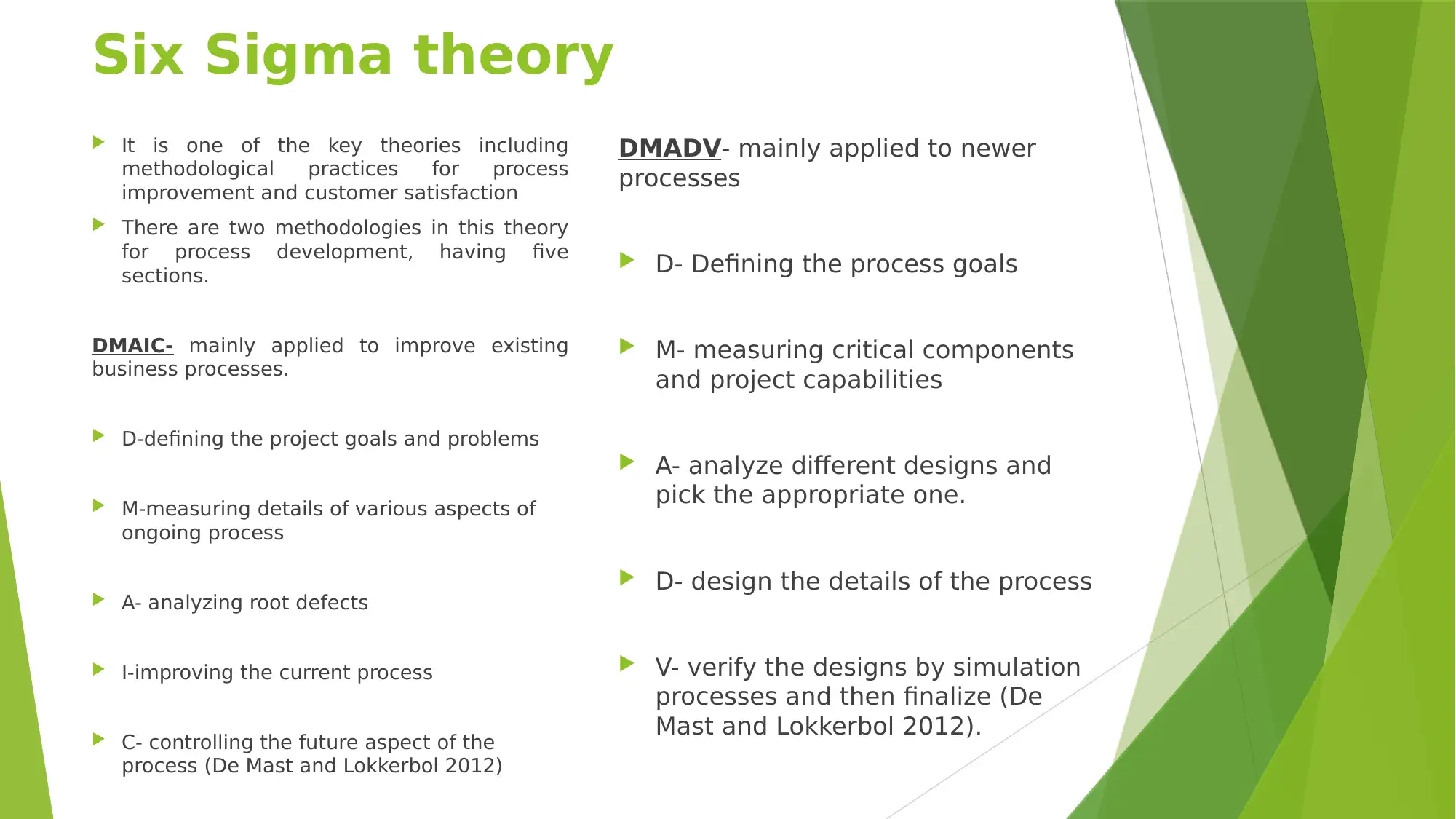
Six Sigma theory
It is one of the key theories including
methodological practices for process
improvement and customer satisfaction
There are two methodologies in this theory
for process development, having five
sections.
DMAIC- mainly applied to improve existing
business processes.
D-defining the project goals and problems
M-measuring details of various aspects of
ongoing process
A- analyzing root defects
I-improving the current process
C- controlling the future aspect of the
process (De Mast and Lokkerbol 2012)
DMADV- mainly applied to newer
processes
D- Defining the process goals
M- measuring critical components
and project capabilities
A- analyze different designs and
pick the appropriate one.
D- design the details of the process
V- verify the designs by simulation
processes and then finalize (De
Mast and Lokkerbol 2012).
It is one of the key theories including
methodological practices for process
improvement and customer satisfaction
There are two methodologies in this theory
for process development, having five
sections.
DMAIC- mainly applied to improve existing
business processes.
D-defining the project goals and problems
M-measuring details of various aspects of
ongoing process
A- analyzing root defects
I-improving the current process
C- controlling the future aspect of the
process (De Mast and Lokkerbol 2012)
DMADV- mainly applied to newer
processes
D- Defining the process goals
M- measuring critical components
and project capabilities
A- analyze different designs and
pick the appropriate one.
D- design the details of the process
V- verify the designs by simulation
processes and then finalize (De
Mast and Lokkerbol 2012).
Paraphrase This Document
Need a fresh take? Get an instant paraphrase of this document with our AI Paraphraser
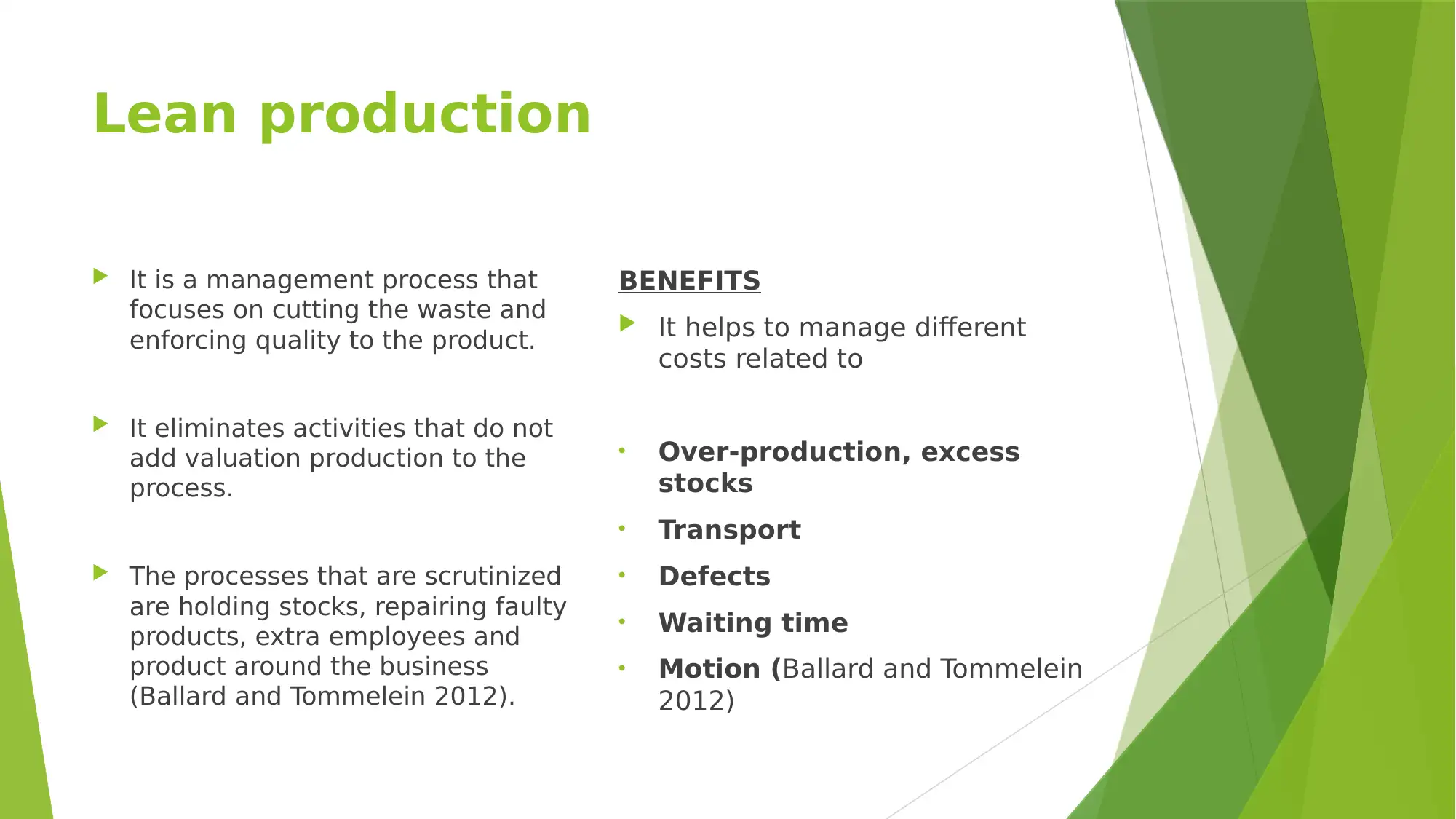
Lean production
It is a management process that
focuses on cutting the waste and
enforcing quality to the product.
It eliminates activities that do not
add valuation production to the
process.
The processes that are scrutinized
are holding stocks, repairing faulty
products, extra employees and
product around the business
(Ballard and Tommelein 2012).
BENEFITS
It helps to manage different
costs related to
• Over-production, excess
stocks
• Transport
• Defects
• Waiting time
• Motion (Ballard and Tommelein
2012)
It is a management process that
focuses on cutting the waste and
enforcing quality to the product.
It eliminates activities that do not
add valuation production to the
process.
The processes that are scrutinized
are holding stocks, repairing faulty
products, extra employees and
product around the business
(Ballard and Tommelein 2012).
BENEFITS
It helps to manage different
costs related to
• Over-production, excess
stocks
• Transport
• Defects
• Waiting time
• Motion (Ballard and Tommelein
2012)
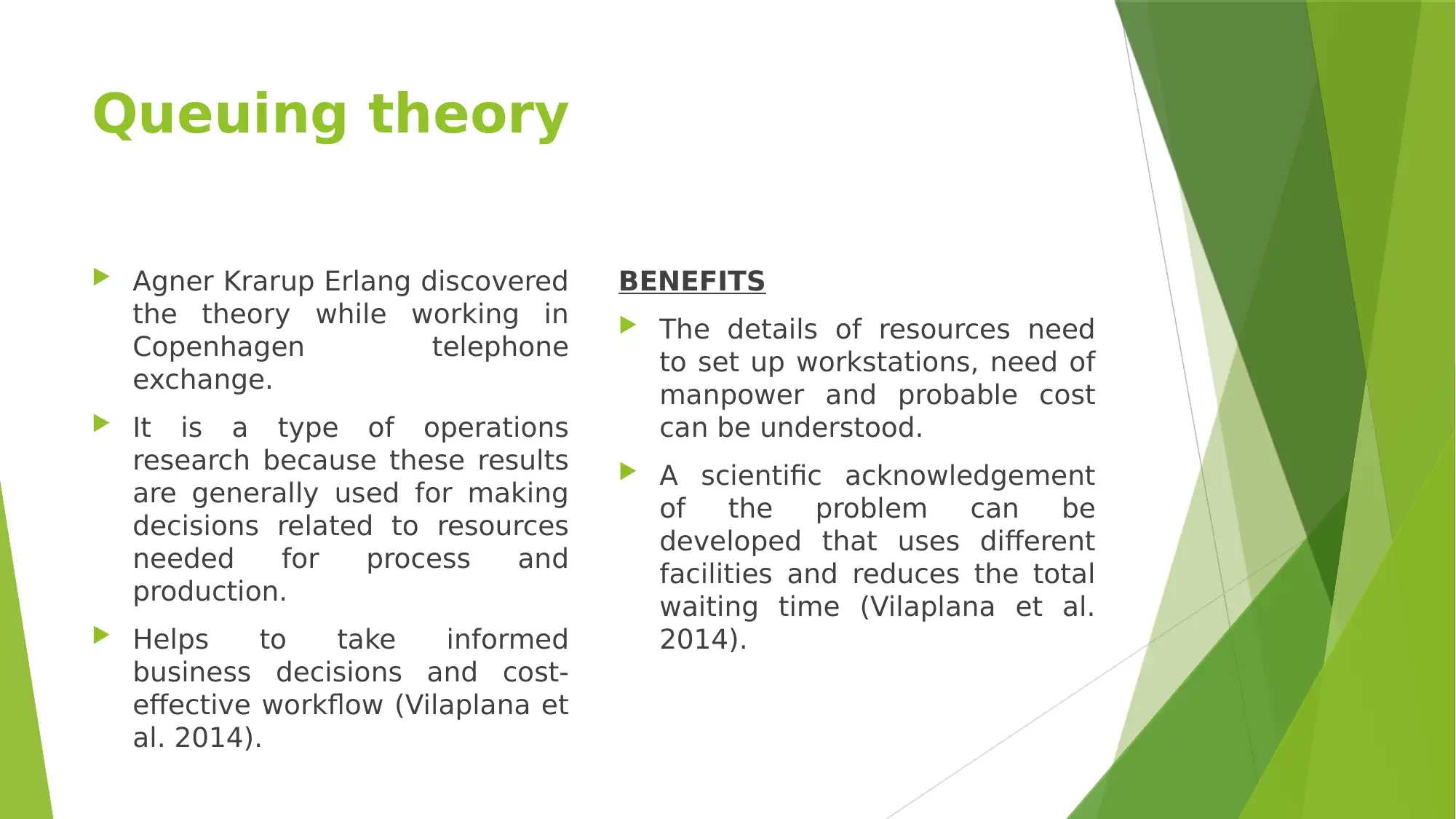
Queuing theory
Agner Krarup Erlang discovered
the theory while working in
Copenhagen telephone
exchange.
It is a type of operations
research because these results
are generally used for making
decisions related to resources
needed for process and
production.
Helps to take informed
business decisions and cost-
effective workflow (Vilaplana et
al. 2014).
BENEFITS
The details of resources need
to set up workstations, need of
manpower and probable cost
can be understood.
A scientific acknowledgement
of the problem can be
developed that uses different
facilities and reduces the total
waiting time (Vilaplana et al.
2014).
Agner Krarup Erlang discovered
the theory while working in
Copenhagen telephone
exchange.
It is a type of operations
research because these results
are generally used for making
decisions related to resources
needed for process and
production.
Helps to take informed
business decisions and cost-
effective workflow (Vilaplana et
al. 2014).
BENEFITS
The details of resources need
to set up workstations, need of
manpower and probable cost
can be understood.
A scientific acknowledgement
of the problem can be
developed that uses different
facilities and reduces the total
waiting time (Vilaplana et al.
2014).
⊘ This is a preview!⊘
Do you want full access?
Subscribe today to unlock all pages.

Trusted by 1+ million students worldwide
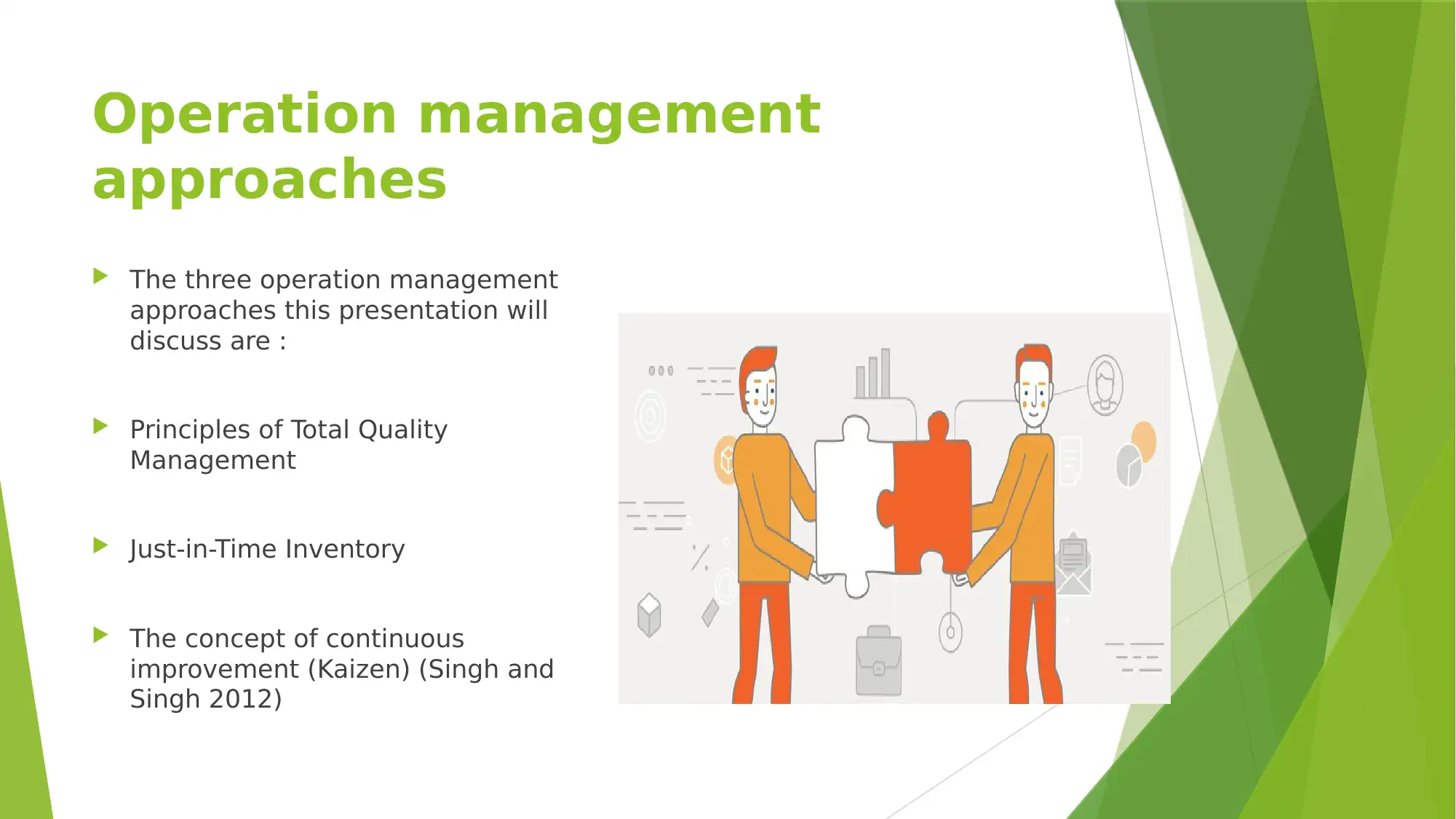
Operation management
approaches
The three operation management
approaches this presentation will
discuss are :
Principles of Total Quality
Management
Just-in-Time Inventory
The concept of continuous
improvement (Kaizen) (Singh and
Singh 2012)
approaches
The three operation management
approaches this presentation will
discuss are :
Principles of Total Quality
Management
Just-in-Time Inventory
The concept of continuous
improvement (Kaizen) (Singh and
Singh 2012)
Paraphrase This Document
Need a fresh take? Get an instant paraphrase of this document with our AI Paraphraser

Principles of Total Quality
Management
This approach uses continuous feedback
approach for continuous development of
the process. The principles are:
Focus on customer
Employee involvement
Process centered
Integrated system
Strategic and systematic approach
Decision making (depending on facts)
Communication
Continuous improvement (Wang, Chen
and Chen 2012)
Application
It helps to identify and complete the
needs of customers on priority basis.
Helps to manage the employees by
providing them training, and using correct
planning for resources
Evaluation of progress so that planning
for next development can be done.
Helps to assess the customer satisfaction,
current trends and quality system of the
organization
Formulate teams that will help to improve
the quality of the product (Wang, Chen
and Chen 2012)
Management
This approach uses continuous feedback
approach for continuous development of
the process. The principles are:
Focus on customer
Employee involvement
Process centered
Integrated system
Strategic and systematic approach
Decision making (depending on facts)
Communication
Continuous improvement (Wang, Chen
and Chen 2012)
Application
It helps to identify and complete the
needs of customers on priority basis.
Helps to manage the employees by
providing them training, and using correct
planning for resources
Evaluation of progress so that planning
for next development can be done.
Helps to assess the customer satisfaction,
current trends and quality system of the
organization
Formulate teams that will help to improve
the quality of the product (Wang, Chen
and Chen 2012)

Just-in-Time Inventory
This inventory strategy helps to
reduce the cost of waste by
allowing the raw materials that
are important for the
production hence, leads to
enhance efficiency too.
This allows the company to not
to hold safety stocks and
operate with low inventory
levels, thereby lowering the
risk of loss of cost
(Manavizadeh et al. 2013).
Application
It helps the company to move
from one product manufacturing
to another easily as the run
time of one product is smaller in
this inventory process.
It helps the organization by
eliminating cost related to
warehouse storage needs as the
company buys raw material
needed for the production of
limited cycle of products
(Manavizadeh et al. 2013).
This inventory strategy helps to
reduce the cost of waste by
allowing the raw materials that
are important for the
production hence, leads to
enhance efficiency too.
This allows the company to not
to hold safety stocks and
operate with low inventory
levels, thereby lowering the
risk of loss of cost
(Manavizadeh et al. 2013).
Application
It helps the company to move
from one product manufacturing
to another easily as the run
time of one product is smaller in
this inventory process.
It helps the organization by
eliminating cost related to
warehouse storage needs as the
company buys raw material
needed for the production of
limited cycle of products
(Manavizadeh et al. 2013).
⊘ This is a preview!⊘
Do you want full access?
Subscribe today to unlock all pages.

Trusted by 1+ million students worldwide
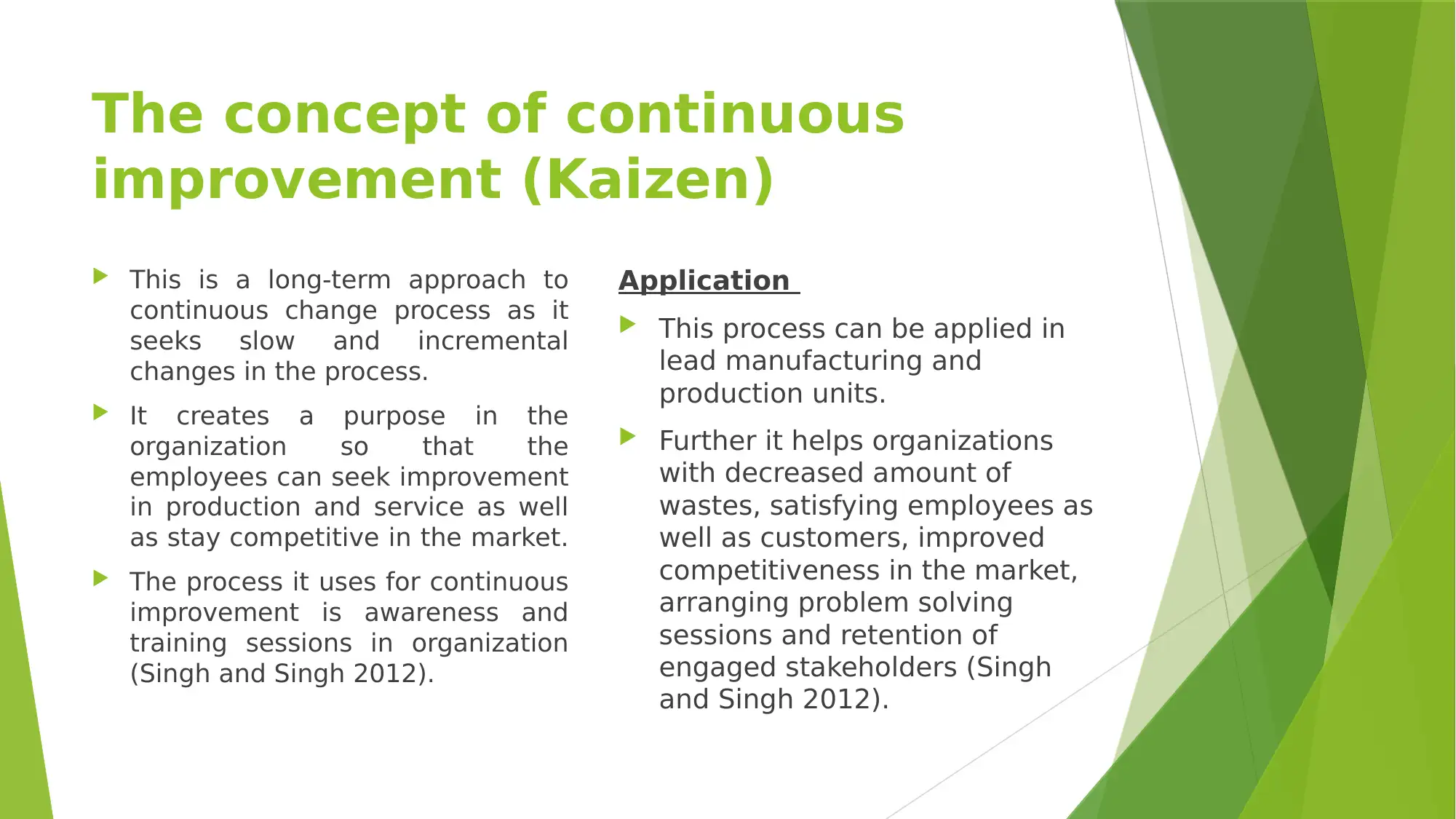
The concept of continuous
improvement (Kaizen)
This is a long-term approach to
continuous change process as it
seeks slow and incremental
changes in the process.
It creates a purpose in the
organization so that the
employees can seek improvement
in production and service as well
as stay competitive in the market.
The process it uses for continuous
improvement is awareness and
training sessions in organization
(Singh and Singh 2012).
Application
This process can be applied in
lead manufacturing and
production units.
Further it helps organizations
with decreased amount of
wastes, satisfying employees as
well as customers, improved
competitiveness in the market,
arranging problem solving
sessions and retention of
engaged stakeholders (Singh
and Singh 2012).
improvement (Kaizen)
This is a long-term approach to
continuous change process as it
seeks slow and incremental
changes in the process.
It creates a purpose in the
organization so that the
employees can seek improvement
in production and service as well
as stay competitive in the market.
The process it uses for continuous
improvement is awareness and
training sessions in organization
(Singh and Singh 2012).
Application
This process can be applied in
lead manufacturing and
production units.
Further it helps organizations
with decreased amount of
wastes, satisfying employees as
well as customers, improved
competitiveness in the market,
arranging problem solving
sessions and retention of
engaged stakeholders (Singh
and Singh 2012).
Paraphrase This Document
Need a fresh take? Get an instant paraphrase of this document with our AI Paraphraser
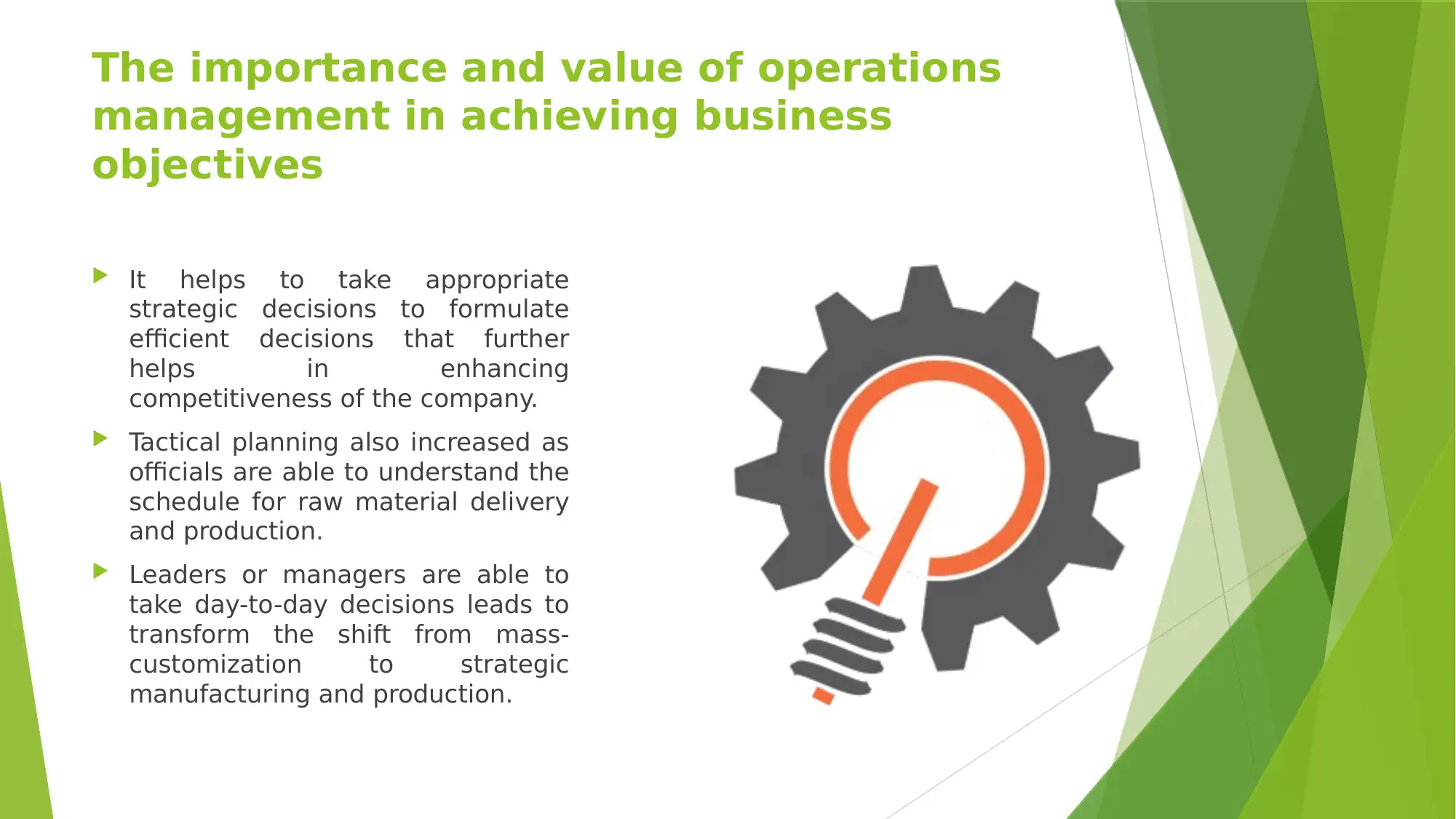
The importance and value of operations
management in achieving business
objectives
It helps to take appropriate
strategic decisions to formulate
efficient decisions that further
helps in enhancing
competitiveness of the company.
Tactical planning also increased as
officials are able to understand the
schedule for raw material delivery
and production.
Leaders or managers are able to
take day-to-day decisions leads to
transform the shift from mass-
customization to strategic
manufacturing and production.
management in achieving business
objectives
It helps to take appropriate
strategic decisions to formulate
efficient decisions that further
helps in enhancing
competitiveness of the company.
Tactical planning also increased as
officials are able to understand the
schedule for raw material delivery
and production.
Leaders or managers are able to
take day-to-day decisions leads to
transform the shift from mass-
customization to strategic
manufacturing and production.
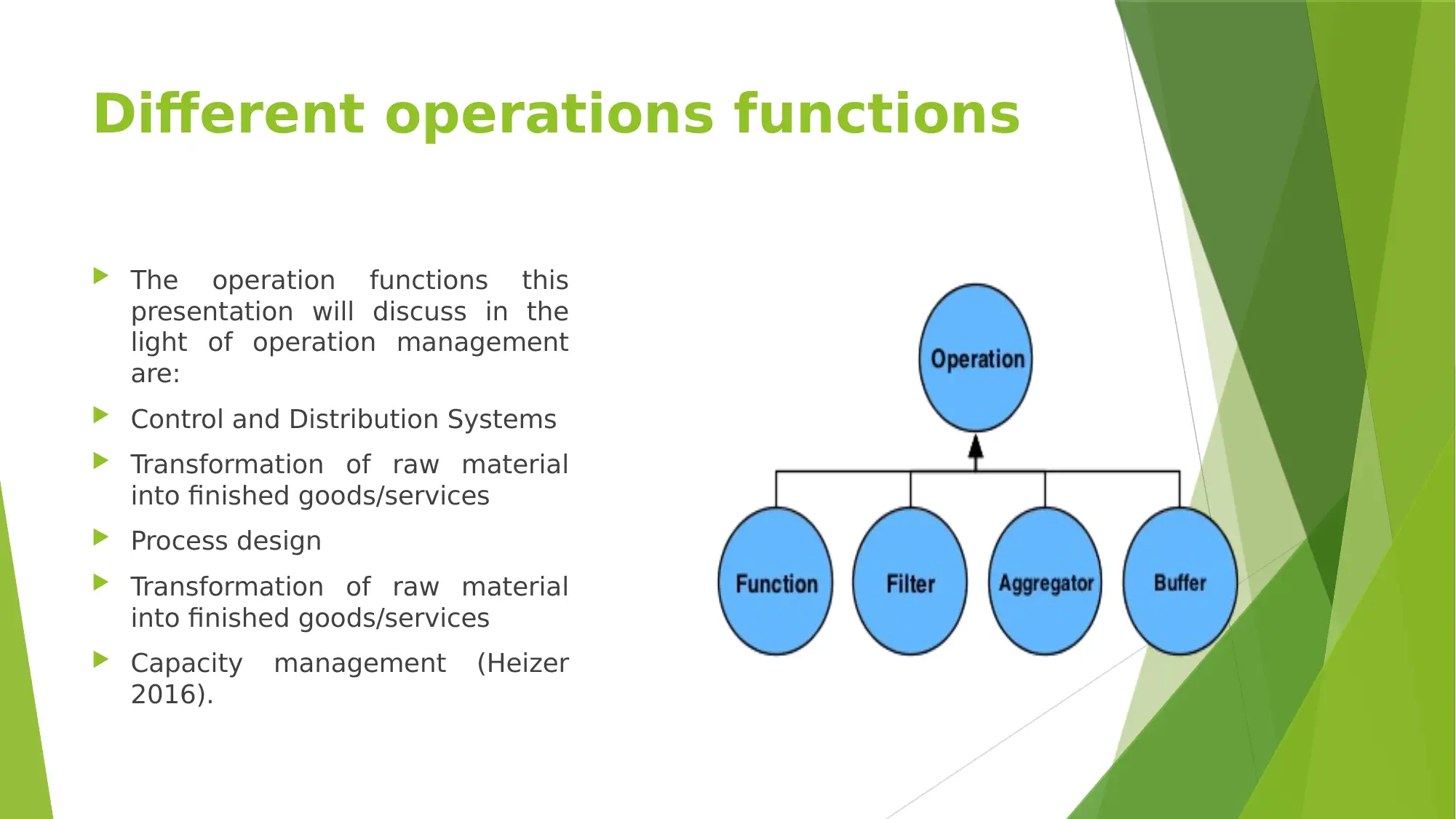
Different operations functions
The operation functions this
presentation will discuss in the
light of operation management
are:
Control and Distribution Systems
Transformation of raw material
into finished goods/services
Process design
Transformation of raw material
into finished goods/services
Capacity management (Heizer
2016).
The operation functions this
presentation will discuss in the
light of operation management
are:
Control and Distribution Systems
Transformation of raw material
into finished goods/services
Process design
Transformation of raw material
into finished goods/services
Capacity management (Heizer
2016).
⊘ This is a preview!⊘
Do you want full access?
Subscribe today to unlock all pages.

Trusted by 1+ million students worldwide
1 out of 19
Related Documents
Your All-in-One AI-Powered Toolkit for Academic Success.
+13062052269
info@desklib.com
Available 24*7 on WhatsApp / Email
![[object Object]](/_next/static/media/star-bottom.7253800d.svg)
Unlock your academic potential
Copyright © 2020–2025 A2Z Services. All Rights Reserved. Developed and managed by ZUCOL.



